One night, I was startled by a loud sound from my cat. It was not just a simple meow. It was a deep, intense cry that needed my attention right away. I learned that cat screaming is more than just noise. It’s a way for cats to communicate their feelings and needs.
Cat yowling can mean many things, from feeling a bit off to having a serious health issue. Knowing what these sounds mean is key to understanding your cat better. It helps you connect with them on a deeper level.
Cats use a complex language of sounds to talk to us. Each sound has its own meaning. Whether it’s a soft chirp or a loud scream, these sounds tell us a lot about what our cats are feeling. Vets and animal experts say that understanding these sounds helps us meet our cat’s needs better.
Exploring the world of cat communication, you’ll learn about the different meanings behind cat screams. This guide will help you understand what your cat is trying to say. From health issues to emotional needs, you’ll know how to support your cat’s communication.
Table of Contents
Understanding Feline Vocalization Patterns
Cats are experts at talking to us, using a complex language. They go beyond just meowing loudly. Their sounds show us how they feel, giving us a peek into their emotional world.
Different Types of Cat Sounds
Cats make many sounds, each with its own meaning. Their voices can express:
- Meows: Primary communication with humans
- Purrs: Showing happiness and comfort
- Hisses: Warning of fear or anger
- Trills: Friendly hello sounds
- Cat wailing: Showing distress or needing attention
Why Cats Vocalize
Cat sounds serve many purposes. Intelligence and communication are key in their behavior. They use sounds to:
- Ask for food
- Get attention
- Show their feelings
- Talk to other cats
- Signal needs
“Cats are capable of incredibly nuanced communication that we’re only beginning to understand.” – Kristin Hulzinga, Cat Behaviorist
Normal vs. Abnormal Vocalizations
It’s important to know when a cat’s sounds are normal or not. While meowing is common, loud or constant wailing might mean health or emotional issues. Watch for any big changes in your cat’s sounds.
Common Reasons for Cat Screaming

Understanding your cat’s sounds can help you figure out why they scream or yowl. Cats make different noises to tell us what they need or how they feel. Their cries are a key way to express themselves.
Several key reasons trigger cat yowling:
- Hunger or food-related demands
- Seeking immediate attention
- Experiencing physical discomfort
- Responding to environmental stressors
- Mating or territorial behaviors
Cats use loud sounds to talk to us. Their screaming might mean something urgent or just be a way to express themselves. It’s important to watch their body language to understand what they’re trying to say.
“Cats speak volumes without uttering a single word.” – Veterinary Communication Specialist
Different things can make cats scream. Hunger might make them yowl short and often, while pain can cause longer, more upset sounds. Territorial cats might scream to mark their area or warn others away.
Watch your cat’s sounds closely. If they keep screaming or making strange noises, it might mean they’re sick. You should take them to the vet to check.
Medical Conditions That Cause Cat Screaming
Cat wailing can be a sign of health problems. It’s important for pet owners to know what medical issues might cause it. This helps them find ways to comfort their cat.
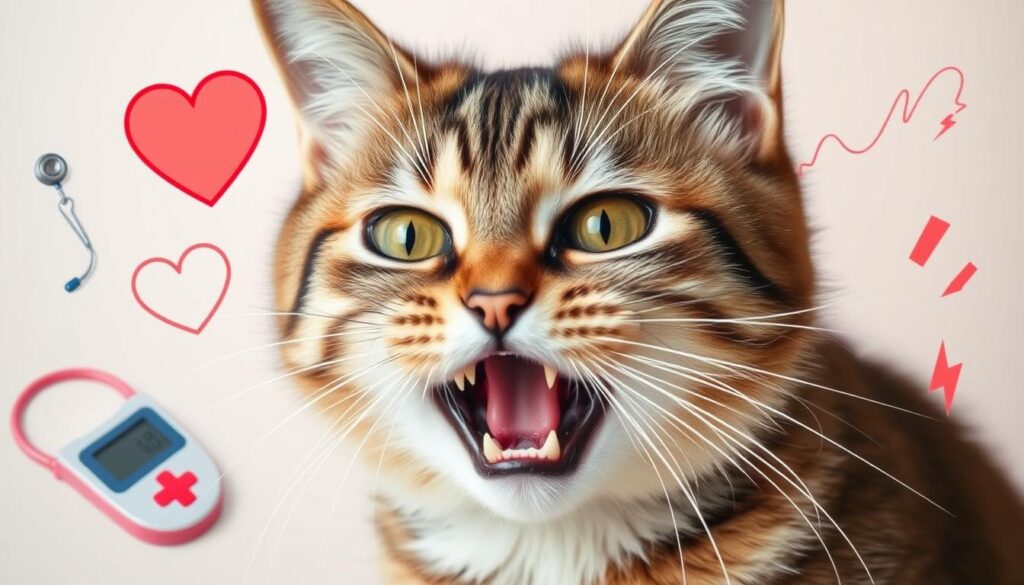
Recognizing Pain and Discomfort
Cats may scream when they’re in pain. This can be due to several reasons:
- Dental problems
- Arthritis
- Internal injuries
- Urinary tract infections
Hyperthyroidism: A Common Culprit
Hyperthyroidism can make cats more vocal. This condition changes their metabolism, leading to:
- Increased vocalization
- Restlessness
- Weight loss
- Elevated heart rate
“Cats cannot verbally tell us when something is wrong, so unusual sounds are their way of signaling distress.” – Veterinary Experts
Cognitive Dysfunction in Older Cats
Aging cats may experience cognitive decline. This can cause them to scream more, especially at night. Signs include:
- Disorientation
- Changes in sleep patterns
- Increased vocalization
- Reduced interaction
If your cat screams a lot or sounds different, see a vet. They can check for health problems and help your cat feel better.
Behavioral Triggers Behind Cat Yowling

Understanding cat caterwauling is key to knowing feline behavior. Cats use different sounds to talk, and yowling is one of the loudest. These loud calls often show stress or need for attention.
Several key triggers can make cats yowl:
- Attention-seeking behaviors
- Territorial disputes
- Emotional distress
- Changes in household dynamics
Cats yowl when they’re anxious or need something. Feline behavior experts say sudden changes can make cats talk more. New furniture, family members, or changes in routine can make them vocal.
| Behavioral Trigger | Typical Yowling Response |
|---|---|
| New Pet Introduction | Intense territorial yowling |
| Owner’s Extended Absence | Persistent, loud vocalizations |
| Home Renovation | Anxious, repetitive yowling |
“Cats don’t just meow—they communicate complex emotions through their vocalizations.” – Feline Behavior Specialist
Knowing what makes your cat yowl can help meet their needs. This can reduce loud meowing. If the yowling doesn’t stop, getting help from a vet might be needed.
Decoding Your Cat’s Distress Signals
Understanding cat crying and feline distress is more than just listening. Your cat talks to you in a complex way. They use body signals to show their feelings and health issues.
Cats are experts at talking without words. Their body language tells you a lot about their feelings and health. Knowing these signs can help you solve problems early.
Body Language Indicators of Feline Distress
- Tail positioning: Tucked under or puffed up suggests extreme anxiety
- Ear movements: Flattened ears signal fear or aggression
- Crouched posture: Indicates feeling threatened or uncomfortable
- Excessive grooming: Can be a sign of stress or underlying medical issues
Emergency Warning Signs
Cat crying can mean serious problems. Look out for these urgent signs that need vet help right away:
- Persistent, high-pitched screaming
- Sudden changes in vocalization patterns
- Unusual body tremors or shaking
- Refusal to move or extreme lethargy
“When your cat’s body language speaks volumes, it’s crucial to listen and act.” – Veterinary Behavioral Specialist
Spotting feline distress early can stop bigger health problems. Trust your gut and get help when you see odd behaviors.
Nighttime Cat Screaming: What It Means

Understanding your cat’s nighttime sounds can help you understand them better. Cat howling at night is not just random noise. It’s a way for them to communicate with you.
Cats are naturally more active at twilight. This is because their wild ancestors hunted during dawn and dusk. This instinct is still in domestic cats today.
“Nighttime cat screaming is often a cat’s way of communicating unmet needs or experiencing discomfort.” – Feline Behavior Experts
- Common reasons for nighttime cat howling include:
- Seeking attention from owners
- Experiencing age-related cognitive changes
- Feeling anxious or stressed
- Potential underlying medical conditions
Older cats are more likely to make noise at night. Cognitive dysfunction syndrome can make them confused and disoriented. This leads to more howling at night.
| Age Group | Nocturnal Vocalization Frequency |
|---|---|
| Kittens (0-1 year) | Low |
| Adult Cats (1-7 years) | Moderate |
| Senior Cats (8+ years) | High |
If your cat screams a lot at night, see a vet. They can check for health problems and find ways to stop the noise.
Territorial and Mating-Related Vocalizations
Cats talk to each other in complex ways. They show their feelings and mark their territory. This is how they interact with their world and other animals.
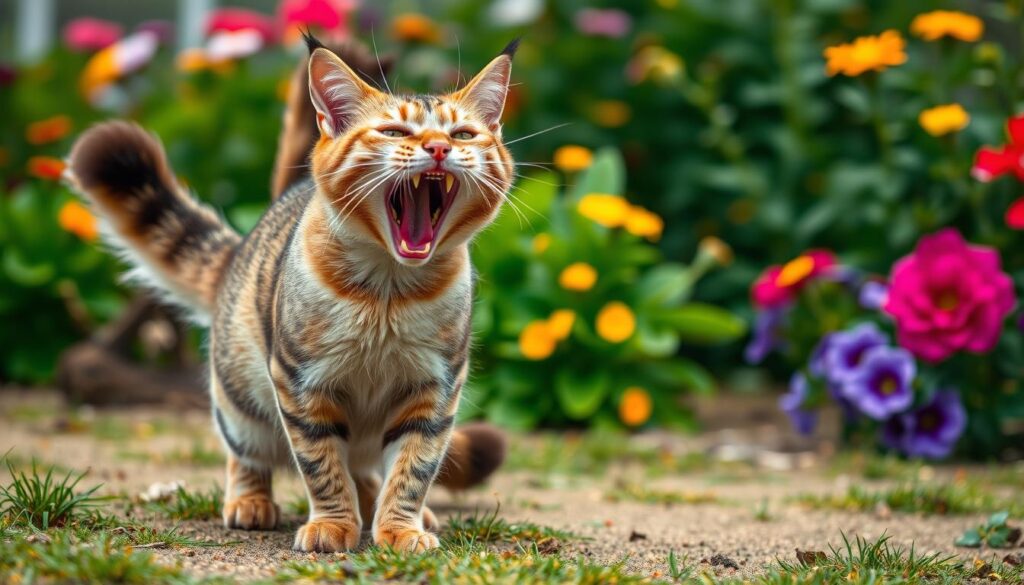
Cat caterwauling has many uses, like during mating and when they fight over territory. Knowing these sounds helps you understand your cat better.
Unneutered Cat Behavior
Unneutered male cats make very loud sounds. These sounds mean different things:
- They’re trying to find a mate
- They’re showing who’s boss
- They’re telling other cats to stay away
“A cat’s voice is its most powerful communication tool in the animal kingdom.” – Feline Behavior Specialist
Territory Marking Through Sound
Cats use sounds to mark their territory. Feline territorial behavior includes special sounds that say:
- This place is mine
- Stay away, I’m watching you
- I’m ready to defend my space
Spaying or neutering your cat can make your home quieter. It helps reduce loud sounds.
Age-Related Changes in Cat Vocalization
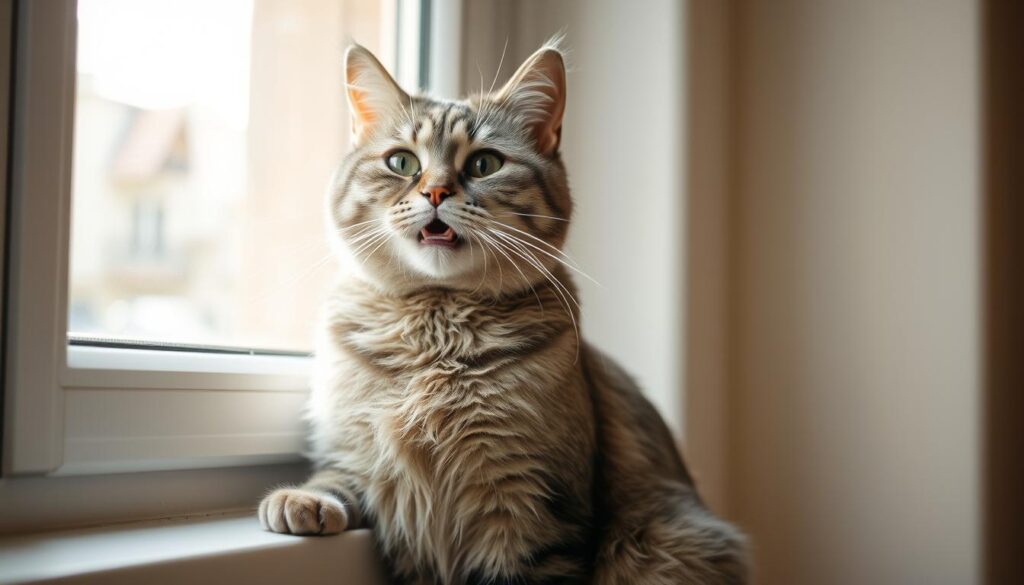
As your cat gets older, you might notice big changes in how they sound. Senior cats start to make more complex sounds. This shows how their body and mind are changing.
Older cats face special challenges when trying to communicate. They might start making new sounds that confuse their owners. These changes come from several reasons:
- Sensory decline affecting hearing and vision
- Cognitive dysfunction in senior cats
- Increased anxiety or disorientation
- Physical discomfort or pain
Knowing about these changes helps you take better care of your aging cat. Senior cats may talk more because of health issues or emotional needs.
“Listening carefully to your senior cat’s sounds can reveal important insights into their health and well-being.” – Veterinary Geriatric Specialists
Here are some common changes in a cat’s voice as they age:
| Age Stage | Vocalization Characteristics |
|---|---|
| 7-10 Years | Gradual increase in nighttime vocalization |
| 11-15 Years | More frequent and louder meowing |
| 16+ Years | Potential cognitive-related vocalization changes |
Regular vet visits are key to keeping an eye on these changes. They help make sure your older cat gets the care they need.
When to Seek Veterinary Care for Cat Screaming
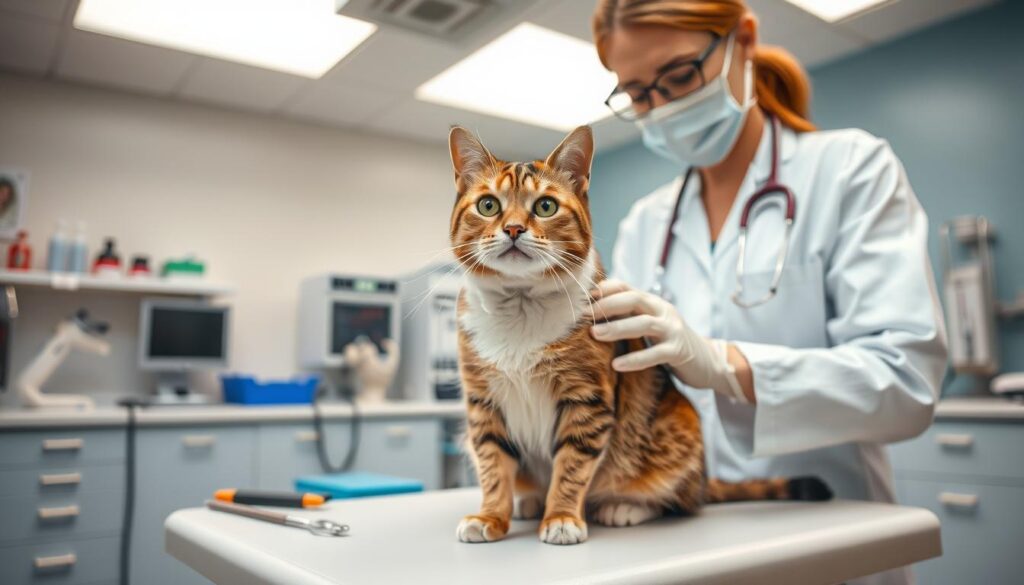
Knowing when your cat’s loud meows mean they need a vet is key to keeping them healthy. Not every loud meow is an emergency. But, some signs are urgent and need a vet’s help right away.
Recognizing Critical Warning Signs
Your cat’s loud meows might mean they have a serious health problem. Look out for these warning signs that mean you need to see a vet fast:
- Sudden changes in how they meow
- Loud meowing with signs of pain or distress
- Having trouble breathing or moving
- Lost a lot of weight
- Feeling very tired or not wanting to move
Emergency Diagnostic Procedures
Vets will do detailed checks to find out why your cat is screaming so much. They might do:
- A full body check
- Tests on blood and other panels
- Imaging like X-rays or ultrasounds
- Checking their nervous system
- Tests for older cats, especially those over 7
“Early detection and intervention can significantly improve your cat’s quality of life and prevent potential long-term health complications.” – Veterinary Specialists Association
Older cats, especially those 11 to 14 years old, need extra care. As your cat gets older, they should see the vet more often. Instead of once a year, they might need to go every six months.
Environmental Factors Affecting Cat Vocalization
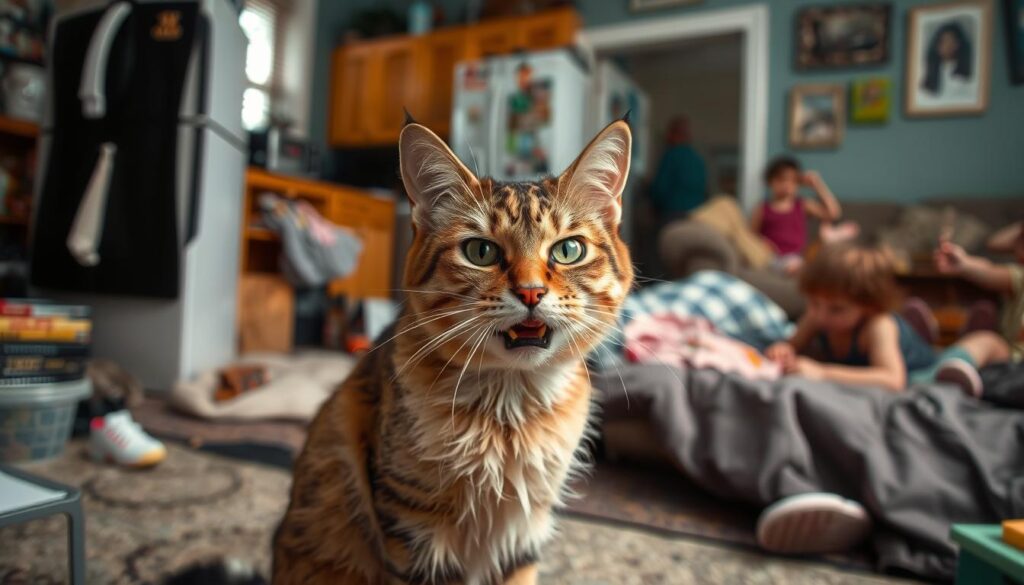
Understanding your cat’s environment is key to managing stress and vocalization. Cats are very sensitive to their surroundings. Changes in their environment can lead to loud vocal responses.
Several environmental factors can affect your cat’s vocalization:
- Household layout and spatial dynamics
- Noise levels and sound frequencies
- Presence of other animals
- Changes in daily routines
“A stable environment is the foundation of a calm cat.” – Veterinary Behaviorist
To create a stress-free environment for your cat, you need a plan. Here are some tips to reduce vocalization:
- Establish consistent feeding schedules
- Provide dedicated quiet spaces
- Minimize sudden environmental disruptions
- Use calming pheromone diffusers
Environmental Stress Impact Comparison
| Environmental Factor | Stress Level | Potential Vocalization Response |
|---|---|---|
| New Pet Introduction | High | Frequent yowling |
| Furniture Rearrangement | Medium | Occasional meowing |
| Consistent Routine | Low | Minimal vocalization |
About two-thirds of cats show anxiety when their environment changes. By managing these factors, you can reduce your cat’s stress and vocalization.
Managing and Reducing Excessive Cat Screaming
Cat behavior training can greatly reduce loud meowing. It makes your home a quieter place. The first step is to understand how your cat communicates.
To reduce stress in cats, you need to tackle both behavior and environment. Cats often scream because they’re anxious or need something.
Effective Behavior Modification Techniques
- Use positive reinforcement when your cat remains quiet
- Establish consistent daily routines
- Reward calm behavior with treats and gentle praise
- Implement short, frequent training sessions
Creating a Calming Home Environment
Your cat’s living space is key to managing loud meowing. Here are some tips for reducing stress:
- Provide multiple vertical spaces and hiding spots
- Use pheromone diffusers to reduce anxiety
- Maintain a predictable feeding and play schedule
- Create quiet zones away from high-traffic areas
“Understanding your cat’s emotional needs is key to reducing excessive vocalization.” – Dr. Sarah Peterson, Veterinary Behaviorist
If home efforts don’t work, consider professional cat behavior training. It offers tailored advice. Remember, patience and consistency are crucial in helping your cat feel safe and quiet.
The Role of Stress in Cat Vocalization
Cat anxiety can change how your feline talks to you. When stress hits, their meows turn into a big warning sign. Knowing these signs helps you fix your cat’s emotional issues.
Feline stress sounds different from regular meows. They might scream, yowl, or make loud, repetitive calls. These sounds show your cat is feeling stressed.
- High-pitched screaming
- Prolonged yowling
- Sudden loud vocalizations
- Repetitive distress calls
Things that stress cats out include:
- Changes in the house
- New pets coming in
- Changes in their routine
- Feuds over territory
- Not enough to do
“A stressed cat speaks volumes through their voice” – Feline Behavioral Experts
Your cat’s mental health shows in their voice. By fixing stress causes, you can cut down on loud meows. This makes your home a calmer place.
Vets say to keep routines, give safe spots, and use calming methods. These steps help manage your cat’s anxiety and reduce loud meows.
Breed-Specific Vocalization Patterns
Exploring feline vocal traits shows that different cat breeds communicate in unique ways. Some breeds are more talkative, while others are quieter.
Some cat breeds are known for their special sounds:
- Siamese cats are famous for their loud, persistent meows
- Oriental Shorthairs talk a lot and with great intensity
- Maine Coon cats make soft, chirping sounds
- Russian Blues are generally quieter and less vocal
Knowing your cat breed’s typical sounds helps you understand their needs and feelings better.
| Cat Breed | Vocal Intensity | Communication Style |
|---|---|---|
| Siamese | High | Loud, frequent meowing |
| Maine Coon | Medium | Soft chirps and trills |
| Russian Blue | Low | Minimal, gentle sounds |
| Bengal | High | Varied, wild-like vocalizations |
Genetic predispositions greatly influence a cat’s vocal traits. While personality matters, breed characteristics offer clues to expected communication styles.
“Every cat breed has a unique voice, just like humans have distinct accents and speaking styles.” – Feline Behavior Specialist
Knowing your cat breed’s typical sounds can deepen your connection with them. It helps you understand their emotional and physical needs better.
Prevention Strategies and Long-term Solutions
Dealing with a cat that screams too much needs a full plan for their health. Their loud meows often mean they need something important. It’s up to us to listen and act fast.
Good cat care means using several important strategies:
- Schedule regular vet visits to catch health problems early
- Make a daily routine for food and playtime
- Use toys to keep their mind and body active
- Try to reduce stress in their environment
It’s vital to understand what your cat is trying to tell you. Cats meow for many reasons. Knowing these can help solve problems before they get worse.
“Prevention is always better than cure in cat care” – Veterinary Experts
Using the right steps can really cut down on too much meowing:
| Strategy | Potential Benefits |
|---|---|
| Environmental Enrichment | Reduces stress and anxiety |
| Consistent Feeding Schedule | Minimizes attention-seeking behaviors |
| Regular Health Monitoring | Catches medical issues early |
Every cat is different. Patience and observation are essential. They help you find the best way to manage your cat’s loud meows.
Conclusion
Understanding why cats scream is complex. It involves medical knowledge, behavior study, and knowing their environment. Your first step is to see each meow as a message from your cat.
To really get what your cat is saying, try a few things. Take them to the vet regularly, reduce stress, and make your home a calm place. Finding out why your cat screams can change how you both feel about each other.
Being patient and watching your cat closely is crucial. By learning their language, you’ll grow closer and live together better. It’s a way to understand and connect with your pet.
Every cat is different, so what works for one might not work for another. Getting help from vets and animal experts can give you tailored advice. This ensures you find the best way to handle your cat’s sounds.

